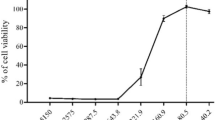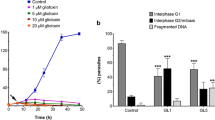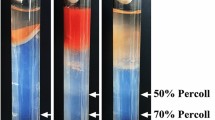Abstract
Egress from host cells is a vital step of the intracellular life cycle of apicomplexan parasites such as Toxoplasma gondii. This phenomenon has attracted attentions from many research groups. Previous studies have shown that ethanol could stimulate the release of microneme proteins by elevating intracellular Ca2+ concentration of T. gondii, resulting in the parasite egress from host cells. However, little information about egress is known on Eimeria species, the causative agent of coccidiosis in poultry and livestock. In this report, we studied the effect of ethanol and isopropanol on the egress of eimerian parasites. Eimeria tenella sporozoites cultured in primary chicken kidney cells were treated with ethanol and isopropanol, then the egressed parasites were analyzed. Ethanol and isopropanol could induce the rapid egress of E. tenella sporozoites from host cells. No substantial damage was found in parasite-egressed host cells. Compared to the freshly isolated sporozoites, the re-invading ability and reproductivity of the egressed parasites significantly decreased by 43.4 and 44.1 % individually. We also found that fewer sporozoites egressed from host cells when the parasites developed for a longer time before the alcohol treatment. These results demonstrate an in vitro egress mode different from that of T. gondii, facilitating the deciphering of the mechanisms of egress of eimerian parasites.




Similar content being viewed by others
References
Arrizabalaga G, Boothroyd JC (2004) Role of calcium during Toxoplasma gondii invasion and egress. Int J Parasitol 34(3):361–368
Behrendt JH, Taubert A, Zahner H, Hermosilla C (2008) Studies on synchronous egress of coccidian parasites (Neospora caninum, Toxoplasma gondii, Eimeria bovis) from bovine endothelial host cells mediated by calcium ionophore A23187. Vet Res Commun 32(4):325–332
Black MW, Arrizabalaga G, Boothroyd JC (2000) Ionophore-resistant mutants of Toxoplasma gondii reveal host cell permeabilization as an early event in egress. Mol Cell Biol 20(24):9399–9408
Blake DP, Tomley FM (2014) Securing poultry production from the ever-present Eimeria challenge. Trends Parasitol 30(1):12–19
Bouchot A et al (1999) Tachyzoite calcium changes during cell invasion by Toxoplasma gondii. Parasitol Res 85(10):809–818
Caldas LA, de Souza W, Attias M (2007) Calcium ionophore-induced egress of Toxoplasma gondii shortly after host cell invasion. Vet Parasitol 147(3–4):210–220
Carruthers VB, Moreno SN, Sibley LD (1999) Ethanol and acetaldehyde elevate intracellular [Ca2+] and stimulate microneme discharge in Toxoplasma gondii. Biochem J 342(Pt 2):379–386
Dong XJ et al (2011) Enhanced egress of intracellular Eimeria tenella sporozoites by splenic lymphocytes from coccidian-infected chickens. Infect Immun 79(8):3465–3470
Hao L, Liu X, Zhou X, Li J, Suo X (2007) Transient transfection of Eimeria tenella using yellow or red fluorescent protein as a marker. Mol Biochem Parasitol 153(2):213–215
Ji YS, Sun XM, Liu XY, Suo X (2013) Toxoplasma gondii: effects of exogenous nitric oxide on egress of tachyzoites from infected macrophages. Exp Parasitol 133(1):70–74
Kafsack BF, Pena JD, Coppens I, Ravindran S, Boothroyd JC, Carruthers VB (2009) Rapid membrane disruption by a perforin-like protein facilitates parasite exit from host cells. Science 323(5913):530–533
Kawaguchi T, Nomura K, Hirayama Y, Kitagawa T (1987) Establishment and characterization of a chicken hepatocellular carcinoma cell line, LMH. Cancer Res 47(16):4460–4464
Kim K, Weiss LM (2004) Toxoplasma gondii: the model apicomplexan. Int J Parasitol 34(3):423–432
Lai L et al (2011) The role of sialyl glycan recognition in host tissue tropism of the avian parasite Eimeria tenella. PLoS Pathog 7(10):e1002296
Liu X et al (2013) Development of transgenic lines of Eimeria tenella expressing M2e-enhanced yellow fluorescent protein (M2e-EYFP). Vet Parasitol 193(1–3):1–7
Long PL, Millard BJ, Joyner LP, Norton CC (1976) A guide to laboratory techniques used in the study and diagnosis of avian coccidiosis. Folia Vet Lat 6(3):201–217
Lourido S, Tang K, Sibley LD (2012) Distinct signalling pathways control Toxoplasma egress and host-cell invasion. EMBO J 31(24):4524–4534
Lovett JL, Marchesini N, Moreno SNJ, Sibley LD (2002) Toxoplasma gondii microneme secretion involves intracellular Ca2+ release from inositol 1,4,5-triphosphate (IP3)/ryanodine-sensitive stores. J Bio Chem 277(29):25870–25876
Nagamune K, Hicks LM, Fux B, Brossier F, Chini EN, Sibley LD (2008) Abscisic acid controls calcium-dependent egress and development in Toxoplasma gondii. Nature 451(7175):207–210
Persson EK et al (2007) Death receptor ligation or exposure to perforin trigger rapid egress of the intracellular parasite Toxoplasma gondii. J Immunol 179(12):8357–8365
Plattner F, Soldati-Favre D (2008) Hijacking of host cellular functions by the Apicomplexa. Annu Rev Microbiol 62:471–487
Roiko MS, Carruthers VB (2009) New roles for perforins and proteases in apicomplexan egress. Cell Microbiol 11(10):1444–1452
Schmatz DM, Crane MS, Murray PK (1984) Purification of Eimeria sporozoites by DE-52 anion exchange chromatography. J Protozool 31(1):181–183
Sibley LD (2010) How apicomplexan parasites move in and out of cells. Curr Opin Biotechnol 21(5):592–598
Stommel EW, Ely KH, Schwartzman JD, Kasper LH (1997) Toxoplasma gondii: dithiol-induced Ca2+ flux causes egress of parasites from the parasitophorous vacuole. Exp Parasitol 87(2):88–97
Suo X et al (2006) The efficacy and economic benefits of Supercox, a live anticoccidial vaccine in a commercial trial in broiler chickens in China. Vet Parasitol 142(1–2):63–70
Tomita T, Yamada T, Weiss LM, Orlofsky A (2009) Externally triggered egress is the major fate of Toxoplasma gondii during acute infection. J Immunol 183(10):6667–6680
van den Hoff MJ, Moorman AF, Lamers WH (1992) Electroporation in “intracellular” buffer increases cell survival. Nucleic Acids Res 20(11):2902
Wiersma HI, Galuska SE, Tomley FM, Sibley LD, Liberator PA, Donald RG (2004) A role for coccidian cGMP-dependent protein kinase in motility and invasion. Int J Parasitol 34(3):369–380
Yin G, Liu X, Zou J, Huang X, Suo X (2011) Co-expression of reporter genes in the widespread pathogen Eimeria tenella using a double-cassette expression vector strategy. Int J Parasitol 41(8):813–816
Zou J et al (2011) Evaluation of Toxoplasma gondii as a live vaccine vector in susceptible and resistant hosts. Parasit Vectors 4:168
Acknowledgments
This research was supported by the National Natural Science Foundation of China (31172309 and Key Project 31330076). All animal researches were approved by the Beijing Association for Science and Technology (approval ID SYXK (Beijing) 2007–0023) and complied with the guidelines of Beijing Laboratory Animal Welfare and Ethics of the Beijing Administration Committee of Laboratory Animals.
Author information
Authors and Affiliations
Corresponding author
Rights and permissions
About this article
Cite this article
Yan, X., Liu, X., Ji, Y. et al. Ethanol and isopropanol trigger rapid egress of intracellular Eimeria tenella sporozoites. Parasitol Res 114, 625–630 (2015). https://doi.org/10.1007/s00436-014-4224-y
Received:
Accepted:
Published:
Issue Date:
DOI: https://doi.org/10.1007/s00436-014-4224-y




